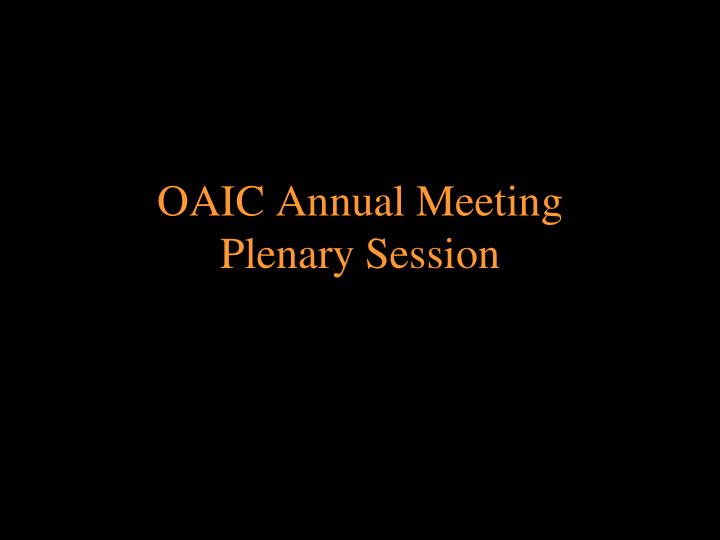



OAIC Annual Meeting Plenary Session
Age and Sex are THE drivers of most diseases and chronic conditions
Age and Sex are THE drivers of most diseases and chronic conditions
Claude D. Pepper Older Americans Independence Centers (OAIC) The goal of the OAIC program is to increase scientific knowledge that allows older adults to maintain or restore their independence.
83 years old; 83 years old; HTN, Hyperlipidemia, prior MI HTN, Hyperlipidemia, prior MI
A new paradigm – address the most common risk factor for all chronic disease simultaneously, and translate it into HEALTHspan
Part 1 Interventions that address aging: success in animal models
Conceptualization: Mechanism of Aging Macromolecular Damage Stress Epigenetics Response Other Stem Cells Biology Metabolism Proteostasis Inflammation Sierra & Kohanski López-Otín et t al . J Gerontol June 2014 Cell 153:1194 (2013) Slide courtesy Felipe Sierra, PhD
Aging mechanisms link to the development of chronic disease Dementia CVD Sarcopenia CKD Chronic Arthritis COPD Damage Disease Stress Diabetes Osteoporosis Adaptation Epigenetics Neurodegeneration Hearing Stem Vision Cells Frailty Inflammation Metabolism Proteostasis Other Biology Slide courtesy Felipe Sierra, PhD
Major advances in lifespan and healthspan improvements-animal models
Senescence Associated Secretory Phenotype ( SASP) – strongly pro-inflam m atory!!
Part 2 Translating anti-aging approaches to humans to improve healthspan
How will we test the hypothesis that anti-geronic approaches enhance healthspan in humans? Slide courtesy Steve Kritchevsky
The Problem of Biomarkers in Aging Research Slide courtesy Steve Kritchevsky
Epigenetics: CHANGES IN METHYLATION AT CPG SITES ALTER GENE EXPRESSION WITHOUT CHANGING THE INHERITED GENETIC CODE. ( Katerina Karavodin) METHYLATION PATTERNS CAN BE USED TO PREDICT A PERSON’S CHRONOLOGIC AGE (S. Horvath Genome Biol. 2013) METHYLATION PATTERNS ARE ALSO BEGINNING TO REVEAL DIFFERENCES BETWEEN CHRONOLOGIC AND BIOLOGIC AGE (Rickabaugh et al. PLoS One 2015)
DNA Methylation – may be the single best marker of “passing time,” i.e. Chronologic Age
DNA Methylation and Age Verified in nearly all tissues (prostate, head & neck, cartilage?)
HIV-1-infection accelerates epigenetic aging Using a multi-variate model that includes methylation patterns, age, and HIV status, Rickabaugh, et al. estimated that HIV-1- infection accelerates aging by ~14 years in ART naïve MACS participants All from the MACS cohort • 24 samples from 20–24 year olds • 24 samples from 48–56 year olds Rickabaugh et al. PLoS • In each group, 12 were HIV-1 seropositive o One 2015 men and 12 were HIV-1 seronegative men • Avg BMI similar, Hep B/ C status similar
What do integrative functional assessments add?
Examples of Functional “biomarkers” • Multi-morbidity/Cumulative deficit scores – Rockwood, VACS (for HIV) • Physical function – Gait speed, grip strength, SPPB/other composite functions, 6 min walk distance • Cognitive function/reserve – MOCA, many others • Vulnerability/Resilience – Fried Frailty Index, Resilience (Psychosocial)
Gait Speed and Survival in Seniors
Slide courtesy Steve Death and Disability Rate by Modified Kritchevsky Physiologic Index score: The Health ABC Study Score based on tertiles of: 1. Systolic Blood Pressure 2. Forced Vital Capacity 3. Digit Symbol Substitution Test 4. Cystatin-C and a priori cut-points of 5. Serum Fasting Glucose (<126; 126- 142,≥142) Sanders J L et al. J Gerontol A Biol Sci Med Sci 2012;67:1439-1446
Physical activity intervention to decrease mobility disability in seniors (LIFE study)
Recommend
More recommend